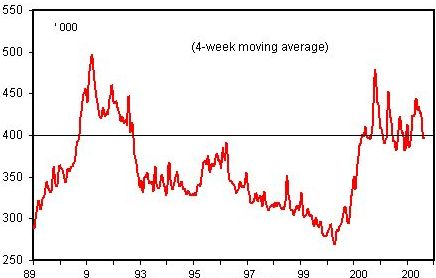|
The conditions of the labour market is very important to a country because it affects consumption expenditure, social stability and government policy.
(1) Unemployment rate
Unemployment rate refers to the number of unemployed persons as a percentage of labour force.

If the labour force is 10 mln persons, the number of unemployed is 500,000 persons, then, the unemployment rate is 5%.
Employed persons are:
(a) All persons who, at any time during the reference week did any work for pay, profit or family gains (as an employer, employee, self-employed or unpaid family worker);
(b) Did not work because of illness, injury, disability, bad weather, vacation, labour dispute and social or religious reasons but had a job, farm, enterprise or other family enterprise to return to;
(c) Temporary lay-off with pay who would definitely be called back to work.
Unemployed persons includes actively unemployed persons and inactively unemployed persons.
Actively unemployed persons are those who did not work during the reference week but were available for work and actively looking for work.
Inactively unemployed persons are:
(a) Persons who did not look for work because they believed no work was available or that they were not qualified;
(b) Persons who would have looked for work if they had not been temporarily ill or had it not been for bad weather;
(c) Persons who were waiting for answers to job applications;
(d) Persons who had looked for work prior to the reference week.
Labour force refers to those, during the reference week, were in the 15-64 years age group and who were either employed or unemployed.
The definitions of labour force, employed, unemployed differs from country to country. For example, in the US, labour force refers to those 16 years or older, no upper limit.
Malaysia’s unemployment rate is released quarterly. Figure 5a - Malaysia’s unemployment rate in 1Q 2003 is 3.8%.

Figure 5a : Malaysia's Unemployment Rate
In the US, the unemployment rate is released monthly. It is a very useful indicator of overall economic health because of its early release (it is released on the first Friday of every month). Figure 5b - Labour market conditions had a great influence on interest rate direction.

Figure 5b : US Unemployment Rate and Fed Funds Rate
(2) Non-farm payrolls
In the US, non-farm payrolls is used together with unemployment rate to gauge the labour market conditions. Non-farm payrolls refers to the number of persons employed in the non-agriculture sectors. It gives the number of persons employed and unemployed. Figure 5c - shows the monthly change in non-farm payrolls. This figure is widely reported in the mass media.

Figure 5c : US non-farm Payrolls
(3) Initial claims
In the US, an even earlier labour market indicator than unemployment rate and non-farm payrolls is initial claims. Initial clams refers to the application to unemployment insurance. It is released every Thursday (US time) for the prior week ending Saturday. Figure 5d - shows the 4-week moving average of initial claims. Initial claims above 400,000 are generally associates with recession.

Figure 5d : US Initial Claims
|



